|
Issue 47 – The Dr. Joe Bauer
-2 Edition - Spring 1999
of History Talk of the Upper
Keys
[This section is under
construction]
- TABLE OF CONTENTS -
1935 - The Great
Hurricane of 1935 - Page 697
1935 Keys Hurricane Introduction
By Jerry Wilkinson
[NOTE: There is a small difference between the paper printed edition
and this electronic edition as the two medias are difference;
therefore, the layout criteria is different - JW]
There have been four books specifically written about the 1935
hurricane excluding the 524 page report on the 1936 Congressional
Inquiry. They are; The Last Train to Paradise by Les Standiford,
The Storm of the Century by Willie Drye, Hemingway’s Hurricane by Phil
Scott and recently published Category 5: The 1935 Labor Day Hurricane
by Thomas Neil Knowles. All four of the books cover the events very
thoroughly while presenting the events in different manners and
perspectives.
This is a photographic
effort with a limited number of before and after images. This requires
twice as many photos, but in my opinion is a good way to compare the
results. Space allocation is an immediate problem when an appropriate
size of image is used. My justification is the preservation of the
photographs and what they represent if the axiom: “A picture is worth a
thousand words” is correct. The details are in the four published
books. I will attempt to be as specific of the locations as possible
without using landmark names that are temporary. With that said, these
are all the sets of Before-After photos that I have, yet I have many
unmatched photos.
The following are six
reasons why this hurricane was significant:
1) Physics - It had the lowest barometric pressure ever recorded over a
land mass in the Northern Hemisphere - 26.35 inches of mercury.
2) Government - Florida had 1,458 World War
One veterans working on government relief projects of which about half
were in the Upper Florida Keys of which about 257 died because of the
hurricane.
3) Politics - The rescue efforts of an
evacuation relief train failed, as well as itself being destroyed
primarily from too late in departure. This failure was blamed on the
government’s failure to act responsibly.
4) Transportation - A major transportation
rail artery was damaged so severely that it had to be abandoned.
5) Communications - The gathering and
relaying efforts of the Weather Bureau failed to serve some of the maritime or terrestrial entities.
6) Loss of civilian life of 228; albeit,
not the greatest of record as there were 8,000 from the 1900 Hurricane
of Galveston and 2,500 in the 1928 Hurricane of Lake Okeechobee.  At the right is a
small version of the chart showing the
path of the 1935 Hurricane. It successfully traveled almost to the
Arctic Circle with the most populated areas being the Upper Keys. Click
the image to enlarge.
The loss of the
approximate 228 civilian lives did not seem to stir national concerns.
The fact that Miami had three competing newspapers did provide
exceptional coverage, especially in quantity, and resulted in fast and
effective local relief efforts. At a national level the fact of being well into the Great
Depression may to some degree have lessened public sensitivity as
almost every one had some degree of hardship. What did capture national
attention was the plight of the WW-I veterans who appeared to again be
victims of political actions.
When the depression
seriously got under way with the stock market crash of 1929, the
veterans across the country began to become organized for their bonus.
A former sergeant named Walter Walters gave a speech on March 15, 1932
which ultimately started a march across the country terminating in
Washington, D.C. with about 20,000 strong.
This is well documented
in books FDR and the Bonus Marches, 1933-1935 by Gary Dean Best and The
Bonus Army, An American Epic by Paul Dixon and Thomas Allen. I added
another entry in 2007 by officially naming the small island just south
of Lower Matecumbe Key as ‘Veterans Key.’ The island resulted from
botanical growth on a small bit of the remains of the bridge approach
that the veterans were building out to their concrete piers at about
MM-73 when the 1935 Hurricane struck.
At the right is a
small version of the chart showing the
path of the 1935 Hurricane. It successfully traveled almost to the
Arctic Circle with the most populated areas being the Upper Keys. Click
the image to enlarge.
The loss of the
approximate 228 civilian lives did not seem to stir national concerns.
The fact that Miami had three competing newspapers did provide
exceptional coverage, especially in quantity, and resulted in fast and
effective local relief efforts. At a national level the fact of being well into the Great
Depression may to some degree have lessened public sensitivity as
almost every one had some degree of hardship. What did capture national
attention was the plight of the WW-I veterans who appeared to again be
victims of political actions.
When the depression
seriously got under way with the stock market crash of 1929, the
veterans across the country began to become organized for their bonus.
A former sergeant named Walter Walters gave a speech on March 15, 1932
which ultimately started a march across the country terminating in
Washington, D.C. with about 20,000 strong.
This is well documented
in books FDR and the Bonus Marches, 1933-1935 by Gary Dean Best and The
Bonus Army, An American Epic by Paul Dixon and Thomas Allen. I added
another entry in 2007 by officially naming the small island just south
of Lower Matecumbe Key as ‘Veterans Key.’ The island resulted from
botanical growth on a small bit of the remains of the bridge approach
that the veterans were building out to their concrete piers at about
MM-73 when the 1935 Hurricane struck.
Speaking of populations, I include my second
chart before the photos - a population chart of Monroe County.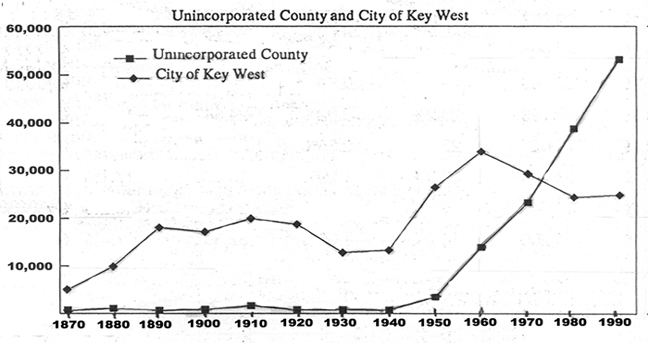
I realize its size is small [Here is a difference in
mediums - you can click to enlarge-JW], but the gist is the population
of all of Monroe County outside of Key West (shown by the shaded
squares) was about 2,000, often less than 1,000, until after 1940.
About 1973 the unincorporated area caught up and begin to exceed the
population of Key West (shown by the shaded diamonds). Also clearly
shown as I have said many times, 1950 verifies the growth outside of
Key West - post WW-II. 1935 is not clearly shown, but population was
stable in numbers. The Upper Keys was not suffering, presumedly because
of the veteran camps. Now to the sets of photos from north to
south.
- I chose Tavernier, shown at the right, as the starting point as it
was the northern most community severely damaged, but still habitable
and I have these two comparison photos. 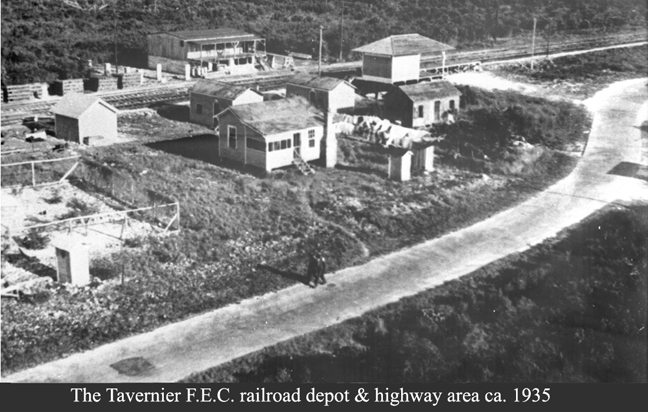 [Note: In the printed version the actual
photos are high resolution 5.5 inch wide photographs - JW] [Note: In the printed version the actual
photos are high resolution 5.5 inch wide photographs - JW]
At the photo’s upper right is the railroad
freight depot with its loading platform extending to its right with an
access driveway from the highway. The depots at Rock Harbor and
Tavernier did not offer passenger services. The track passes just above
the depot from right to left which is now the southbound lane of
highway US-1. There is a large packinghouse across the tracks which is
bayside. In the lower portion is shown the old highway with two people
walking. The open area below the photo is now Old Settler’s Park at MM
91.8. The Hugh McKenzie business center began only a few feet to the
left of this photo. The fenced area is for his petroleum storage area.
The lower photo is more or less of the same area,
but includes more of the foreground. All that remains of the railroad
depot is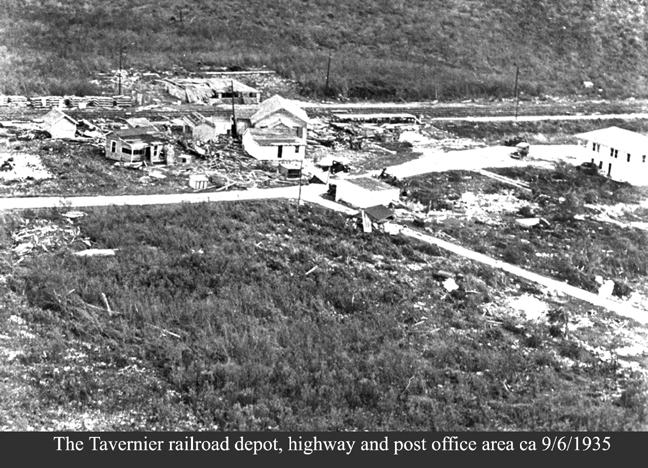 the loading ramp. The larger house
at the center, Merlin Albury’s, had floated over the highway and rammed
the depot building which disintegrated. The packinghouse across the
tracks is in shambles. Except for the small white storage building at
top-left, most of the F.E.C. buildings shown in the top photo are piles
of debris. the loading ramp. The larger house
at the center, Merlin Albury’s, had floated over the highway and rammed
the depot building which disintegrated. The packinghouse across the
tracks is in shambles. Except for the small white storage building at
top-left, most of the F.E.C. buildings shown in the top photo are piles
of debris.
In this photo at center-right we see the Harold
Albury two-story post office built in 1926 and it remains today. About
center is a small building not seen in the top photo and it was the
Tavernier School building. The whitish area at the lower right was the
house of Roger Albury and whose property today is Old Settler’s Park.
The curved portion of highway SR 4A exists today and serves to exit the
highway so to enter/exit the park.
To the south of Tavernier, Plantation Key was
decimated to the best of my knowledge and I have no pairs of
before-after photos, so I move to Snake Creek.
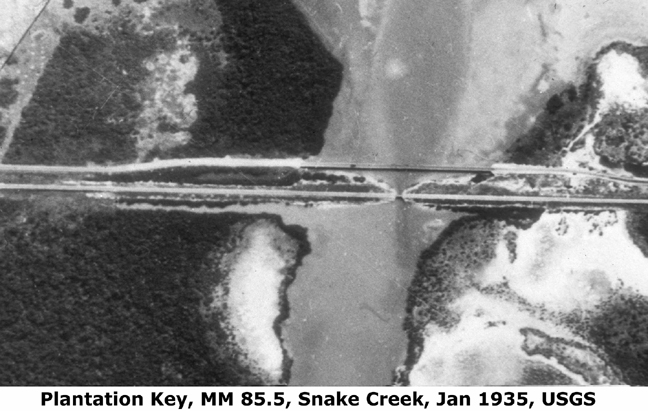 - I have no before photos of Snake
Creek bridge other than this image extracted from an U.S.G.S. aerial photo. The ocean
is to the top and the bay at the
bottom. Tavernier is to the left. Across the middle are two
horizontal lines of which the top line is the highway and built in
1927/28. The bridge’s approach was built with wooden piles with a
wooden framework bolted to the tops. The highway remained oceanside of
the railroad until about MM 80.2.
- I have no before photos of Snake
Creek bridge other than this image extracted from an U.S.G.S. aerial photo. The ocean
is to the top and the bay at the
bottom. Tavernier is to the left. Across the middle are two
horizontal lines of which the top line is the highway and built in
1927/28. The bridge’s approach was built with wooden piles with a
wooden framework bolted to the tops. The highway remained oceanside of
the railroad until about MM 80.2.
The lower line was the railroad with rock filled
approaches to its bridge, two concrete abutments and most likely steel
beams to support the tracks. The width of the opening was 25 feet;
therefore, most of the total width of the creek was an earthen dam. The
grade was 9.3 feet above mean sea level.
At the right is seen the damage that the storm surge
water did to both bridges. The driven wooden piles remained presumedly
because the surging waters could pass between them while at the same
time the uplifting effect removed t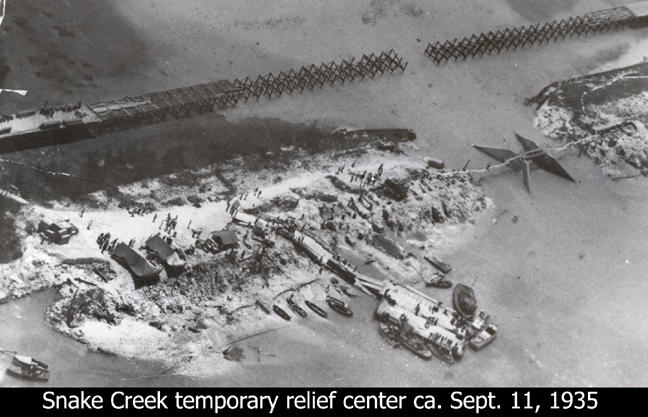 he decking. At
the left end it is seen that new decking is already in process. he decking. At
the left end it is seen that new decking is already in process.
Both ends of earthen filled approaches for the
railroad bridge were washed away leaving the two concrete abutments in
the center. It cannot be clearly seen on this 3.5 by 5.5 inch
reduction, but wooden planks were suspended with cables for a makeshift
walkway across the creek. There appears to be a pontoon airplane at the
lower left.
Vehicle traffic could pass to and from this point
and a makeshift dock was prepared at the lower center. The dock is
relatively large here so I assume the stated date is very close to
being correct. This area became the relief and transportation center
for the Upper Keys. As can be seen in this photo the railroad bed
became a relief community with all forms of shelters used and more were
added as time passed.
Since I have a lack of ‘Before” photos and the north
east side of Snake Creek bec ame a community
of itself, I will use two more ‘After’ photos. These two photos show
the lower right dock area of the previous page
at earlier periods. By late Friday afternoon there were about 800
relief workers and 400 more by late Saturday afternoon. Most of these
had to rest, eat and sleep some place. ame a community
of itself, I will use two more ‘After’ photos. These two photos show
the lower right dock area of the previous page
at earlier periods. By late Friday afternoon there were about 800
relief workers and 400 more by late Saturday afternoon. Most of these
had to rest, eat and sleep some place.
The photo to the right is a Leo Johnson image
showing the construction of a ramp down the bayside slope of the
railroad right-of-way but no date. They appear to be using new lumber
and not debris. The actual dock is said to be a section of the Overseas
Highway bridge decking shown at the top of the photo on the previous
page and very well could be the missing center section.
I am not certain of the details for arranging for
this quick quantity of relief workers, their transportation, their
support and their pay plus all the materials neede d, but it
happened. Considering the unemployment in the middle of the Great
Depression probably did not hinder things. I will not suggest exact
dates. d, but it
happened. Considering the unemployment in the middle of the Great
Depression probably did not hinder things. I will not suggest exact
dates.
The docking area in this photo appears to be no more
than an extension to the ramp. I assume the wooden caskets are empty
and being distributed. Then there is the presence of large
volunteer pleasure boats anchored, which I understand waned after the
injured were removed and the Governor’s decree (September 7th) to
cremate the bodies found on-site was made.
This area would be about MM 85.8. Note to my
referenced Mile Markers: I am using US-1 highway addresses as they do
not vary as much as mile markers on maps do. The highway addresses
usually are four, five or six digit numbers whose three least
significant digits are the structure numbers. Digits to the left of
these three are the mile marker from Key West. They are not always
correct either, but reasonably fixed.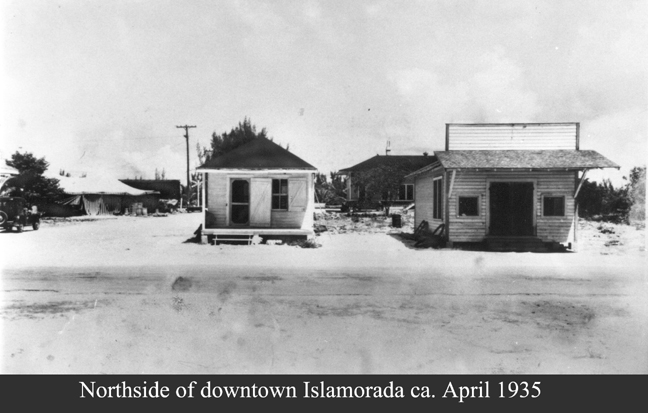
- I do not have great before-after photos for Windley Key so on
to Upper Matecumbe Key. There is more on the photo to the right
than is seldom seen. This was the commercial center of
“Islamorada.” Only the roof’s eave of the post office can be seen at
center left. The parked car is in front of it. In front of the parked
car is a tent which by the time of the hurricane was replaced by a
wooden warehouse. The street in front of the post office and warehouse
is De Leon Avenue and leads across the track to home of engineers
William Krome and Phillip Wilson on the bay. The gray area at the
bottom is the highway - to the right is Tavernier. The small building
at center-left is the office for local FERA administrator B.M. Duncan
who actually had his primary office at Key West, therefore, his state
engineers such as Ed Sheeran. Right of that is the office of the FERA
purchasing agent J.G. Gilmer. In back of Gilmer’s building is the
Islamorada depot. All this is at about MM 82.8 as is the lower photo.
The after photo is from a different angle - looking
almost north. None of the buildings shown on the top photos remain
other than in the form of debris piled against the wrecked train and
the white patterns of their foundations. 
Locomotive 447 and its oil tender are at the lower
right facing north as they had been turned around at Homestead. The
large white area at the upper right is the ‘mystery school’ - a school
to be, but has no documentation. De Leon Avenue passed below it, across
the highway, by the post office whose remains can be seen if you look
carefully. The post office was made of coral rocks and its remains are
at the SW corner of De Leon and the Old Highway. If you noted a power
pole in the top photo, it stands alone in the lower photo - the corner
of De Leon and the railroad crossing. Nine of the train cars are
visible and originally there were a total of 11 - two of the box cars
are missing.
The elevation of the rail bed was
about 8.2 feet at this point. The home of local fishing guide, Leo
Johnson, did survive and would be off this photo and to the left of
center of the overturned train cars - the only remaining residence in
the 40 miles of devastation. Presumedly, the train cars blocked the
rush of the storm surge. As we move south the community at that time
changed names to Matecumbe. 
- At MM 81.8 on the old highway there was a coral rock road that went
to three Matecumbe community entities - the Matecumbe church, school
and cemetery - all clustered very close together. Since there is only
space for one photo I chose the school house. It had a twin building at
Rock Harbor which exists today as the coral rock portion of the Moose
Lodge. Both were built in 1926. Before this school, the school
previously was at the East end of Upper Matecumbe Key. The only
documentation I have of it is in the October 4, 1894 school board
minutes approving the pay of then teacher, William A. Perpau, $40 a
month at the East End Matecumbe School. I have an idea that the school
might have been in a wooden church building photographed by one of the
railroad photographers in 1909. At the time of 1935 hurricane the
teachers were Charles Albury and Ferran Pinder. The Cheeca Lodge
occupies this location now and the cemetery has been preserved. The
property went into private ownership after the 1935 Hurricane when Hugh
Matheson exchanged property he owned bayside for the Works Progress
Administration (WPA) to build a new school and the Florida Keys
Memorial contiguous with highway at about MM 81.5. 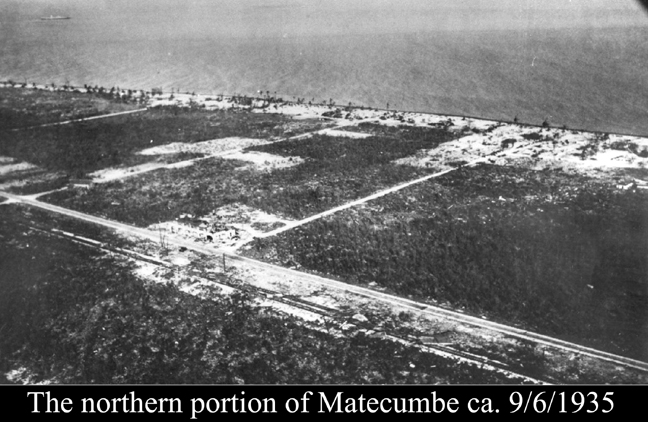
The aerial photo at the right is a large scale
aerial taken by the Coast Guard almost immediately after the hurricane.
Across the upper portion indicating the shoreline, there are three
white sandy areas along the beach. The left white blotch was the
school, church and cemetery area. The middle blotch was the Matecumbe
Club area and the right area was the homes of the Pinder families.
Until the railroad and highway came along most activities were along
the beach. A few concrete water cisterns and foundations survived,
otherwise all was lost as were the church and school. The cemetery did
survive as most of it was at ground level, or below. Barely visible at
the upper left is the 321-foot ship Leise Maersk which is aground.
Moving inland from the beach, the whitish square at
center-left was the Matecumbe Hotel remains. The old highway passed in
front of the hotel with the railroad tracks below it. The railroad is
shown by the second diagonal white line, The right-of-way for the
railroad is now highway US-1 and the old highway remains. The whitish
areas represents sand washed from the beach and spread onto barren
areas. Locals believe the large white spot at center-left as the
remains of a tomato farm that had not grown back.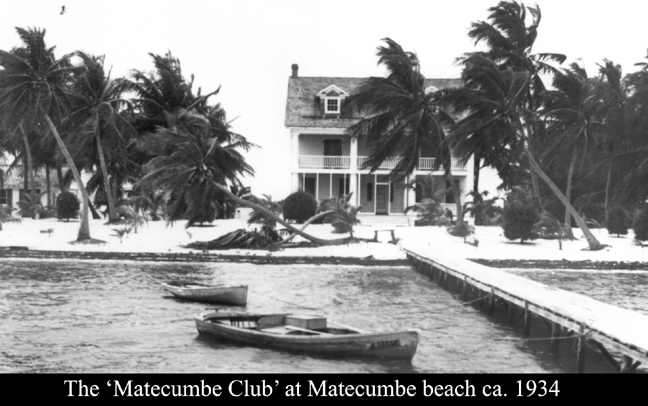
- Matecumbe was the home of a rather unique club considering the times.
Wilbur Johnson and Archie Gwathway of the New York Cotton Exchange
purchased the ocean site using S.W. Eccels as the builder and completed
the building in 1919. It is not clear how it formed, but when finished
it was the Matecumbe Club with a membership limited to 14 members -
each had to be a millionaire. Locals called it the Millionaire’s Club.
The first floor was the lounge area, the second floor had five bedrooms
with baths and the loft area was a great dormitory. The building at the
far upper left was for support personnel for cooking, cleaning, etc.
Bertram Pinder was the club’s manger/caretaker and his brother, Russell
Pinder, was the fishing guide. The club had a huge electric generator
at the rear of the property and commercially wired for electric
service. The Matecumbe Club is also referred to as the Matecumbe
Fishing Club, Islamorada Fishing Club and the Millionaire’s Club. The
Miami Herald of April 11, 1926 included it in a Keys article of the
community of Matecumbe. See History Talk, Issue 30. Islamorada is
relatively a new name coming into use with the railroad in 1908.
A surviving photo of its foundation is below. It is
a repeat of scenes all along the beach areas which was impacted by the
full force of both winds and surge.
In general, about all that was found were concrete foundation and water
cisterns. Some wooden and other floatable items were found which
floated back with the receding waters.
The club’s concrete water cistern is seen at the
center-right, but it also had a huge elevated water tank to gravity
feed water with pressure throughout the club. The mile marker reference
is 81.8
It appears that the damaged greenery is beginning to
put out new sprouts, hence I assume a few months have passed, maybe
even to the spring of 1936. There are two unidentified men in the
photo. There is no documentation of the disposition of the Matecumbe
Club property other than later Lunsford and Smith Richardson, owners of
the Vick’s company, built a large house on at least part of the
property. Their house was converted into the Olney Inn by Clara Mae
Downey who after it was damaged by hurricane Donna sold it to Carl and
Cynthia Twitchell in 1961 who built the Cheeca Lodge.
- According to the Butters’ family, Fern and Ed Butters bought
the Hotel Matecumbe in 1931 for $80,000 at MM 81.5. The original Mile
Markers were called “Mile Posts” by the railroad, they were triangular
in shape and displayed both the miles from Jacksonville and the miles
from Key West.
Anticipating the new Overseas Highway two Key West
Russells, Doddridge and Burnell, built the hotel in 1928. A same year
business brochure listed Islamorada and Matecumbe separately - as they
were then. In Islamorada were: Florida Fish and Lobster Co., Capt. R.
H. Russell, Motlow’s Grocery, Russell’s Marine Gas Station, Islamorada
Fishing Camp and Ocean View Cafe. In Matecumbe were: Matecumbe Boat
Works, Hotel Matecumbe, Rock House Fishing Lodge.
The Butters rented the hotel to FERA, but kept
the kitchen and dining room. The hotel therefore became the
headquarters for operation of the three Veteran Work camps under Ray
Sheldon. The state engineering and professional personnel had various
other offices, but primarily at the aforementioned buildings across
from the Islamorada post office.
There are four ‘after’ photos of the hotel. I chose
this one as it included the Atlantic shoreline which basically extends
the previous aerial photo southwards - the remainder of the Matecumbe
Pinder home sites. There is nothing new to add here - the shoreline
properties were gone. Today (5/3/09) I spoke with Laurette Pinder
Russell to verify that I had the order of the shoreline properties
correct. She was 16 in 1935 and had attended the school, the church and
visited the club many times - two of her brothers worked for the club
and she lived on the beach minutes south of its location. In talking
about all the properties she again mentioned of how much of the beach
sand appeared to have disappeared. It may appear in this photo that the
building could have been repaired but this is the ‘lee’ side.
Structurally, it would have to be totally rebuilt. They did not have
insurance.
Again the highway passed in front of the hotel and
the railroad next to it. The poles were railway property and was for
telephone and telegraph. Other than the Matecumbe Club and Caribbee
Colony, electricity was a thing of the future.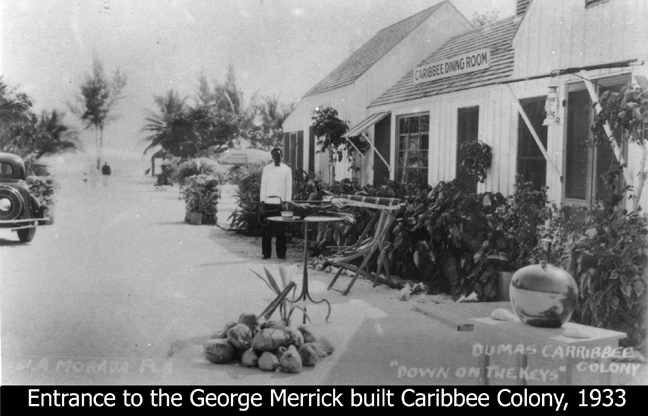
- Another famous place at the time was the
Caribbee Colony built by George Merrick, who developed Coral Gables,
Florida envisioning a great university. The University of Miami opened
in 1926, but the hurricane a few months later severely damaged Coral
Gables. His wife owned most of lower Upper Matecumbe Keys and he built
the Caribbee Colony as a second project. The estimated completion date
is 1930. The photo at the right is a post card. Shown is the
restaurant, but it also had cottages, pier, dance hall, thatched palm
chickee huts and more. Like the Matecumbe Club he had electricity
installed through out the resort, especially a brightly lit
over-the-water dance pavilion. Merrick had guests brought down daily in
train cars with a quota of 500. His daily ‘South Seas Special’ left the
F.E.C. Miami Royal Palm Park Station daily at 9:00 a.m. and returned at
7:00 p.m. The resort was managed by the Dumas family and the
advertisements that I have show it as the Dumas Caribbee Colony. The
1935 hurricane destroyed the Caribbee Colony. The entrance to the
restaurant shown above was at about MM 80.2 which is the La Siesta
Resort today.
Another postcard image of the Caribbee Colony
revealing little difference along the Atlantic shoreline from other
post hurricane images. One difference - a cast iron bath tub. Metal
appliances such as tubs, cooking stoves, bed frames, etc. were found at
other locations. It is believed that there were 26 people at the
Caribbee Colony and only four are known to have survived. Wade and
Marie Dumas are included in the deceased. In this and the Matecumbe
Club after image we see palm trees broken In wet-slow moving hurricanes
the water has time to loosen the soil and they blow over.
George Merrick continued his family real estate
business at Miami which like many more was failing in the Great
Depression. He refused to declare bankruptcy in 1940 and became the
Postmaster of Miami using a portion of his salary to pay off his debts.
- I do have before photos of the three Veteran’s Work Program
camps sites, but no ‘After’ photos of the two camps on this page. Both
encampments were directly on the ocean front, but generally all
inhabitable dwellings were! As we have seen form previous aerials, all
structures along the beach were obliterated. page. Both
encampments were directly on the ocean front, but generally all
inhabitable dwellings were! As we have seen form previous aerials, all
structures along the beach were obliterated.
The Federal Emergency Relief Administration (FERA)
was created on May 22, 1933 and provided state assistance for the
unemployed and their families, and for projects on either public or
private properties. In 1934 the WW-1 veterans were included as the
Veterans Conservation Corps (VCC), copied but modified after the CCC
program. The CCC’s had an age limit of 28 well under the veterans
average age of 41 years. Only the states of Florida and South Carolina
participated using the WW-1 veterans. There were eight numbered
veteran’s camps in Florida.
Camp One at MM 85.2/3 is shown above at the right
and was the first built; therefore, the oldest. It began with 50 men in
November 1934 as an advance party to built cooking and eating
facilities. The following week 256 more men arrived to clear and build
living facilities using what I call cabin-tents - wooden floors and
walls with canvas roofs. They were first called Veteran’s
Rehabilitation Camps, a name quickly challenged by the veterans -
Rehabilitate us from what? The name was changed in April 1935 to
Veteran’s Work Camps. Note at the top center there is an elevated water
tank for running water. Snake Creek is in the background and the ocean
is to the immediate right. build
living facilities using what I call cabin-tents - wooden floors and
walls with canvas roofs. They were first called Veteran’s
Rehabilitation Camps, a name quickly challenged by the veterans -
Rehabilitate us from what? The name was changed in April 1935 to
Veteran’s Work Camps. Note at the top center there is an elevated water
tank for running water. Snake Creek is in the background and the ocean
is to the immediate right.
Camp Five at MM 77.4 was built as an overflow site
for the primary work Camp 3; therefore, it was the newest camp in the
Keys. They continued using the cabin-tents for sleeping quarters, but
built wooden buildings for general purpose facilities. The up grading
of all the structures was programed. Each camp in the Keys was to
provide for up to 250 veterans and were self sustaining other than the
hospital was at Camp 1. All three camps were fully operational at the
first printing of The Key Veteran News in March 1935.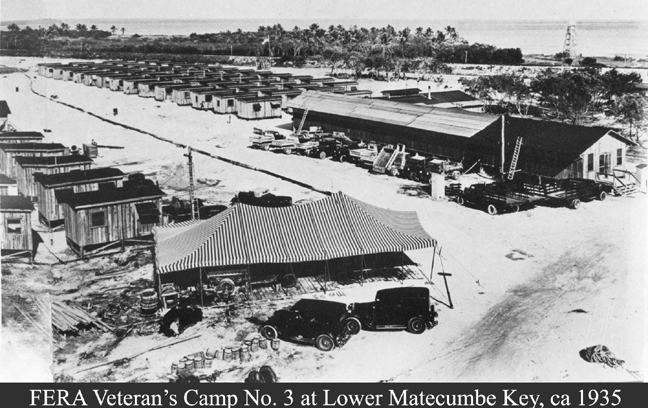
- Camp Three was a living and working site. This was the ‘leaping
off point” for the proposed four miles of bridges and eight miles of
road to connect to the existing road at northern Grassy Key. It was at
the northwest, or bayside of the railroad and highway which are in the
background of the photo.
At the upper right there is a single wooden water
tower very near the main tracks as it was filled from rail tank cars.
The large striped tent, and the one on page 702, were replaced by the
time of the hurricane. Here we see the absence of the cabin-tents.
Progress had taken place very fast considering that the first land
clearing in preparation for Camp One was only ten months earlier.
What is not seen is the construction area that
occupied all the shoreline and the immediate off shore waters where the
bridge piers and approachways were being built by state-of-the-art
equipment. The shoreline was a mini-seaport for receiving and
distribution of supplies and equipment to build an overseas highway to
the existing highway at the Grassy Key ferry landing at about MM 59.5.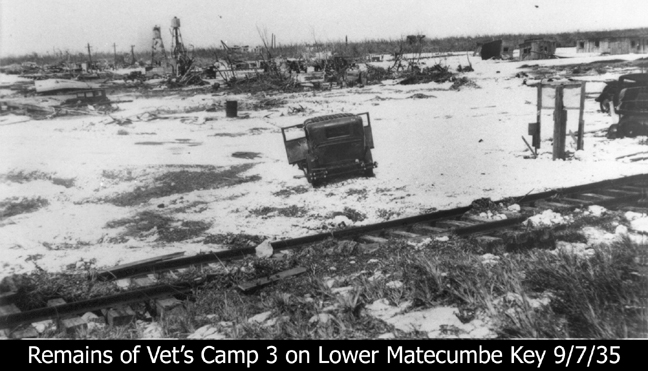
I have three photos of this area to show before I
move on to Long Key. There are many photographs of post hurricane Camp
3, but I chose this one since it shows that there was not total
destruction. At top right are actually a couple of the wooden houses -
not to say that any thing of use survived. One reason for this
could be that Camp 3 was on the NW side of the railroad track which
formed a 8.8 feet above sea level road bed and starting to climb even
higher as it approached the Channel 2 Bridge which was 18 feet above
sea level. This earthen dam acted as a buffer dam and also
deflected/diverted some of the storm surge northward. The photo below
is looking across the island’s tip close to northward at two new steel
water towers more or less in the center of the camp from about MM 73.9.
They were to be commissioned for use on September 3, 1935. The railroad
track just below (to the left of this photo) was upturned on its right
side and did not come apart - it was simply twisted.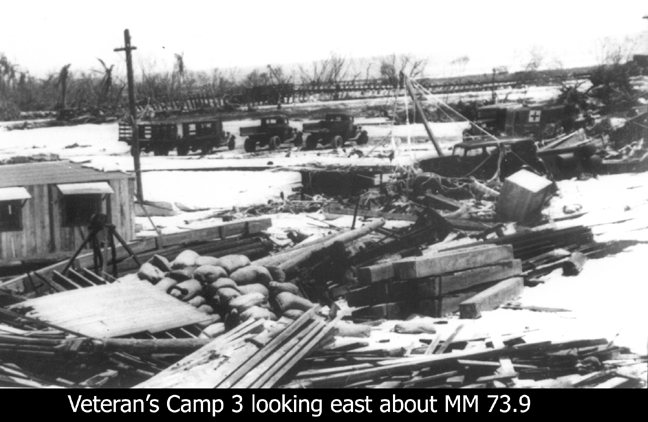
- Camp Three was a large camp compared to the camp
numbers 1 and 5 as it also was the working site for the new bridge.
Looking eastward from the water towers. Note the ambulance and the
assortment of trucks still parked in a row. At center left the storm
shutters survived in the open position, unless some one opened them
after the hurricane. The large wooden timbers at center-right appear to
be reasonably stacked. In the background near the waters edge the
railroad track is standing on its side ends still connected as a track.
The parked trucks would be above the top-left of the photo below.
The aerial photo to the right depicts much of the
remains of public and private Lower Matecumbe entities: railroad,
highway, ferry landing, Crosland Fish Co., Terminal Inn. Other than
this tip of land, all of Lower Matecumbe Key was deeded to four men.
At the right is the railroad track standing on its
side at the upper part and laying flat at the lower part. At its lower
right is the remains of the ferry boat Monroe County. I believe just
above that is the Bradford’s houseboat, but could be the Rowena, a
floating bar. At the center is the ferry landing which appears to be
usable with a car out on the wooden approach. Just to the left of the
ferry landing is the commercial dock of the Crosland Fish Co. of Miami.
A hundred or so feet above the ferry landing was where the Bradford
Terminal Inn used to serve ferry customers and the veterans. The entire
upper left is a small portion of Camp 3.
The lower right train track goes to the Channel 2
bridge and on to Craig Key. The upper right track goes to the left
corner of the photo on the previous page. The left side is the
shoreline of Camp 3. Below that shoreline is Veteran’s Key which was
the beginning of the dredged approach to the eight concrete piers.
- To the right is the quarterboat ‘Sarasota’ used by Ed Sheeran and his
state of Florida State Road Department (SRD) personnel on ‘loan’ to the
Veterans Work Program. It has never been made clear how the ‘technical
and professional’ personnel, versus the ‘administrative - laborer’
personnel were organized. My take is that B.M. Duncan at Key West was
in charge of the former and Fred Ghent at Jacksonville was in charge of
the latter. The on-site ‘engineering’ boss was Ed Sheeran who lived at
Coral Gables and had done similar work for Henry Flagler. His crew
operated the mechanized pile drivers, excavators, dredges, concrete
mixers, etc. - about $400,000 of equipment. Photos of some of this
marine construction equipment appear to have contractor’s names painted
on the sides, but there is no mention of any contractors. It appears
that the U.S. government reimbursed only the costs of the actual
vet erans and the
state paid all other costs. erans and the
state paid all other costs.
The Federal ERA was only created for two years and
this was a huge project to begin half way through its
contract life.
The Works Progress Administration (WPA) assumed FERA’s functions. I
have never found primary documentation of operational and organization
details of the Florida ERA.
The Sarasota was a huge barge with office-living
quarters built on its deck. The offices and dormitories were above deck
and sleeping cooking, dining, showers, storage, etc., were below deck.
Sheeran moved it into Hurricane Creek before the hurricane. The creek,
was now more or less a canal, had been used by Flagler as a safe harbor
and was redredged by Sheeran. Sheeran had evacuated all but essential
and volunteer personnel to the mainland before the hurricane. He had
about 30 people aboard during the hurricane - all survived without
injury.
The lower photo is the Sarasota post hurricane with
tents on its fore deck. - This former construction camp
was touted as a stopover in
1908 when daily train services were provided to Knight’s Key Dock. By
1910 it was advertized as the Long Key Fishing Camp. The depot is
elevated because of its nearness to the two-mile bridge which climbs to
over 30 feet above sea level over water. This was a sizable resort
occupying the entire southwestern tip of the island. The 75-room hotel
and 14-cabins were on the eastern side between the ocean and the
railroad track. The fishing docks, staff quarters, maintenance and
support facilities were on the bayside. The large wooden hotel was
built at the southern end and cabins were built under palms trees to
its north along the beach. Zane Grey stayed in one of the cabins while
fishing and writing one of his books. This was the only mandatory rest
stop between Miami and Key West. All construction was of wood other
than piers and retaining walls. The depot had Western Union service and
was an official weather reporting station. Manager James Duane was also
the
- This former construction camp
was touted as a stopover in
1908 when daily train services were provided to Knight’s Key Dock. By
1910 it was advertized as the Long Key Fishing Camp. The depot is
elevated because of its nearness to the two-mile bridge which climbs to
over 30 feet above sea level over water. This was a sizable resort
occupying the entire southwestern tip of the island. The 75-room hotel
and 14-cabins were on the eastern side between the ocean and the
railroad track. The fishing docks, staff quarters, maintenance and
support facilities were on the bayside. The large wooden hotel was
built at the southern end and cabins were built under palms trees to
its north along the beach. Zane Grey stayed in one of the cabins while
fishing and writing one of his books. This was the only mandatory rest
stop between Miami and Key West. All construction was of wood other
than piers and retaining walls. The depot had Western Union service and
was an official weather reporting station. Manager James Duane was also
the weather
observer. weather
observer.
At the right is the Long Key Fish Camp after the
hurricane between MM 65.8 to 65.5. As seen the railroad track runs
diagonally from lower left (Tavernier) through the camp and to Marathon
at the upper right. I believe at center-left is the Lady Ashley house
in which the survivors rode out the hurricane. To its right would have
been the hotel and to its left the cabins. Across and to the right of
the railroad tracks were the docks, maintenance and support personnel
quarters.
According to Duane at 9:20 p.m. the ‘eye’ of the
hurricane passed over Long Key for a duration of 55 minutes meaning
both eye walls passed over it. The Corps of Engineers estimated the
storm surge was 16 feet, it was declared a total loss yet none to the
20 people perished or were seriously injured - amazing!
The last photo was on the back, or
address page of History Talk Issue 47. It is a ground level view of the
relief train wreck looking northwards with a side view of locomotive
number 447. A temporary track, know as a shoo-fly track, was built
through the Upper Keys to retrieve what ever equipment the Florida East
Coast Railway wanted. The right-of-way was sold to the state for about
$600,000 and the release of some taxes owed.
Hope you have enjoyed this form of the presentation
of history - JW
-----End-----
|
